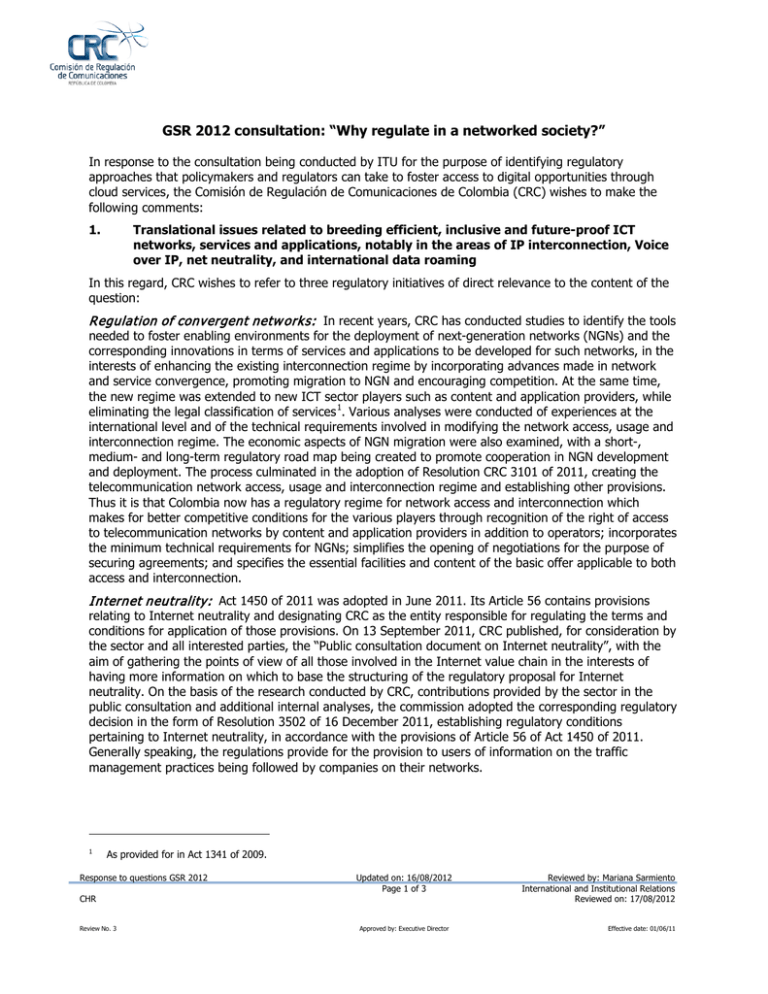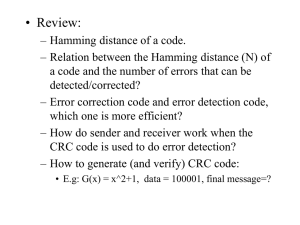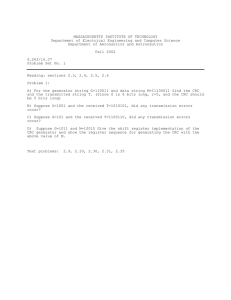GSR 2012 consultation: “Why regulate in a networked society?”
advertisement

GSR 2012 consultation: “Why regulate in a networked society?” In response to the consultation being conducted by ITU for the purpose of identifying regulatory approaches that policymakers and regulators can take to foster access to digital opportunities through cloud services, the Comisión de Regulación de Comunicaciones de Colombia (CRC) wishes to make the following comments: 1. Translational issues related to breeding efficient, inclusive and future-proof ICT networks, services and applications, notably in the areas of IP interconnection, Voice over IP, net neutrality, and international data roaming In this regard, CRC wishes to refer to three regulatory initiatives of direct relevance to the content of the question: Regulation of convergent netw orks: In recent years, CRC has conducted studies to identify the tools needed to foster enabling environments for the deployment of next-generation networks (NGNs) and the corresponding innovations in terms of services and applications to be developed for such networks, in the interests of enhancing the existing interconnection regime by incorporating advances made in network and service convergence, promoting migration to NGN and encouraging competition. At the same time, the new regime was extended to new ICT sector players such as content and application providers, while eliminating the legal classification of services 1. Various analyses were conducted of experiences at the international level and of the technical requirements involved in modifying the network access, usage and interconnection regime. The economic aspects of NGN migration were also examined, with a short-, medium- and long-term regulatory road map being created to promote cooperation in NGN development and deployment. The process culminated in the adoption of Resolution CRC 3101 of 2011, creating the telecommunication network access, usage and interconnection regime and establishing other provisions. Thus it is that Colombia now has a regulatory regime for network access and interconnection which makes for better competitive conditions for the various players through recognition of the right of access to telecommunication networks by content and application providers in addition to operators; incorporates the minimum technical requirements for NGNs; simplifies the opening of negotiations for the purpose of securing agreements; and specifies the essential facilities and content of the basic offer applicable to both access and interconnection. I nternet neutrality: Act 1450 of 2011 was adopted in June 2011. Its Article 56 contains provisions relating to Internet neutrality and designating CRC as the entity responsible for regulating the terms and conditions for application of those provisions. On 13 September 2011, CRC published, for consideration by the sector and all interested parties, the “Public consultation document on Internet neutrality”, with the aim of gathering the points of view of all those involved in the Internet value chain in the interests of having more information on which to base the structuring of the regulatory proposal for Internet neutrality. On the basis of the research conducted by CRC, contributions provided by the sector in the public consultation and additional internal analyses, the commission adopted the corresponding regulatory decision in the form of Resolution 3502 of 16 December 2011, establishing regulatory conditions pertaining to Internet neutrality, in accordance with the provisions of Article 56 of Act 1450 of 2011. Generally speaking, the regulations provide for the provision to users of information on the traffic management practices being followed by companies on their networks. 1 As provided for in Act 1341 of 2009. Response to questions GSR 2012 CHR Review No. 3 Updated on: 16/08/2012 Page 1 of 3 Approved by: Executive Director Reviewed by: Mariana Sarmiento International and Institutional Relations Reviewed on: 17/08/2012 Effective date: 01/06/11 Regulatory fram ew ork for protection of users’ rights: Resolution CRC 3066, containing the new arrangements for protection of the rights of communication service users, was approved on 18 May 2012. Its Article 37 includes conditions for the provision of international roaming services, whereby i) service providers may activate international roaming services only at the express request of the user, through a notification mechanism, with the user specifying the period of activation; ii) mobile telephony providers must publicize the conditions under which they activate and provide international roaming services and, where applicable, the existence of additional charges; and iii) prior to roaming services being used outside the home country, the provider must send the user a free-of-charge text (SMS) message specifying the additional charge applicable to each call made by accessing the international network, or the charge incurred for having the facility to use communication services outside the home country, even when such services are not actually used. 2. Data protection, data sovereignty, privacy issues (including child online protection) and responsibilities of the various stakeholders In 2011, CRC carried out a study on cloud computing. Among other things, the study identified success stories involving companies at the international and national levels having implemented cloud solutions. In the case of Colombia, the success stories had to do with the adoption of virtualization models by companies such as Une EPM Telecomunicaciones, Carvajal Información, Grupo ISA and Ecopetrol. The study also identified the need for strict analysis of the activities which, in each case, need to be carried out in order to migrate corporate information to the cloud, drawing the conclusion that the issue of information safeguards could limit adoption of this solution owing to the fear that a cloud service provider could ultimately sidestep its responsibility for the information in its care, citing reasons associated with the policy of the country in which its infrastructure is installed. This being the case, in addition to putting forward innovative ideas in this regard, CRC expects this year’s GSR to make known the relevant experiences of other countries and to seek ways in which to clarify the situation with a view to the elaboration of corresponding guidelines (where necessary). 3. Public-private partnerships (PPP): strategies for expanding cloud services It is worth mentioning under this heading that the government initiative entitled “Vive Digital” 2 encompasses strategies which include the forging of public-private partnerships in the interests of infrastructure deployment. Particular attention is drawn to the following: – Expansion of the national fibre-optic network: The objective here is to strengthen the core communication network and thereby eliminate bottlenecks which hamper wider network deployment and greater (Internet) service penetration nationwide. The goal is to bring optical fibre to the 700 least connected municipalities by 2014, enabling them to communicate with those already connected and with international networks. – Increasing the number of international connections: The aim is to have sufficient international connectivity to support a 20-fold 3 increase in the current level of internet traffic. We are moving ahead with a consultancy exercise that will enable the analysis of proposed measures for fostering investment in international connectivity infrastructure. – Installation within the country of CDN and data-centre infrastructure: The aim is to provide incentives for content, CDN 4 and data-centre companies to install infrastructure in Colombia. Also to install mirror servers in Colombia so that the traffic remains within the country, thereby reducing international transaction costs and content access times. 2 3 4 Information available at www.vivedigital.gov.co Capacity in 2010: 0.2 terabytes per second Content delivery networks Response to questions GSR 2012 CHR Review No. 3 Updated on: 16/08/2012 Page 2 of 3 Approved by: Executive Director Reviewed by: Mariana Sarmiento International and Institutional Relations Reviewed on: 17/08/2012 Effective date: 01/06/11 Finally, where implementation of the Vive Digital plan is concerned, the following are noteworthy goals for 2012: – 136 per cent growth in internet connections, rising from 2.2 million at the start of this Government to 5.5 million in 2012. In late 2011, optical fibre was commissioned for the connection of 1 078 municipalities (378 more than initially planned). To date, 325 of the country’s municipalities are connected by optical fibre. – In 2009, only 17 per cent of households had an internet connection, whereas by the end of 2011 the figure was 32 per cent, an increase of almost 90 per cent. An agreement has been signed with Colombia’s Ministry of Housing, guaranteeing that social-interest and priority houses have at least one broadband internet connection and equipment. Response to questions GSR 2012 CHR Review No. 3 Updated on: 16/08/2012 Page 3 of 3 Approved by: Executive Director Reviewed by: Mariana Sarmiento International and Institutional Relations Reviewed on: 17/08/2012 Effective date: 01/06/11




